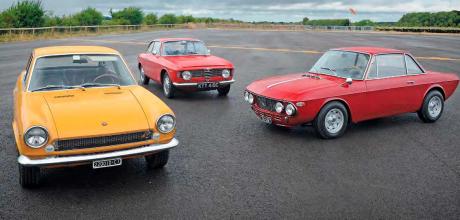1968 Fiat 124 Sport Coupe ‘AC’ vs. 1967 Lancia Fulvia 1.3 Rallye S, 1965 Alfa Romeo Giulia Sprint GT
These 1960s showroom pin-ups from Alfa Romeo, Fiat and Lancia are all talented everyman coupes. But which one has the most charm and allure on the road?
Story by Simon Charlesworth
Photography by Michael Ward
Style With Substance
ALFA GIULIA V LANCIA FULVIA V FIAT 124 COUPE
1960s coupe triple test
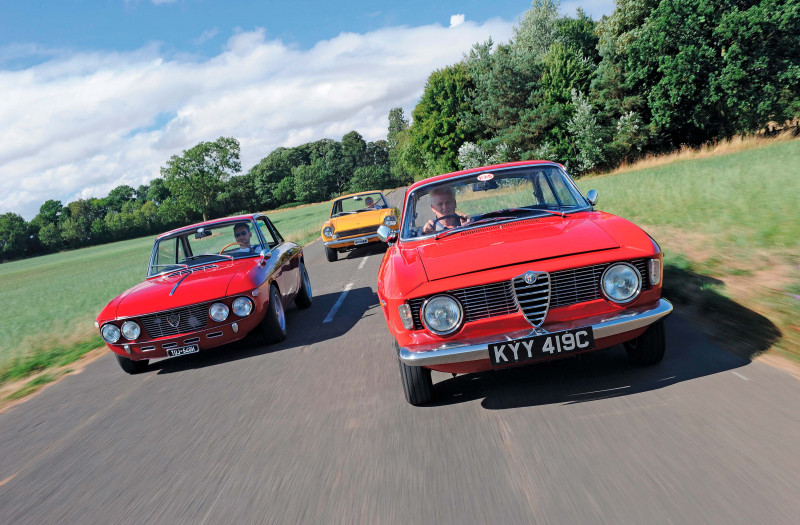
This trio of Italian coupes epitomises the less is- more approach to great design. Each is a masterclass in aesthetic minimalism, so distinctive that it can be easily identified solely by its silhouette. Admire these designs and it’s no wonder that they lasted so long in production – up until 1977 in the Alfa’s case. But today we’re assessing the cars as they first appeared: Alfa Romeo Giulia Sprint GT (first seen in 1963), Lancia Fulvia Coupe (1965) and Fiat 124 Sport Coupe (1967).
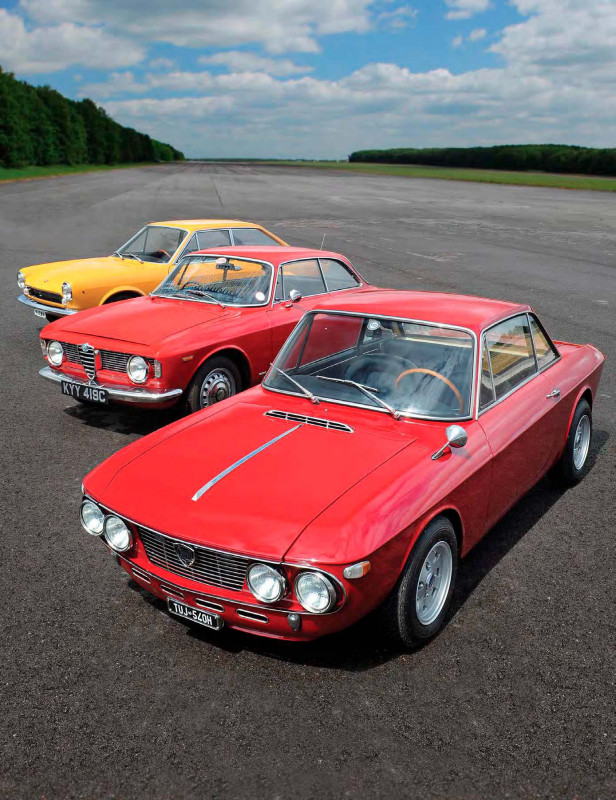
The Alfa was styled by Giorgetto Giugiaro, and whilst there are similarities between this and his 1960 2000 Sprint, there is a touch of stylistic subversiveness about the Sprint GT. Gone is the modest coherence of the Sprint, replaced by a more angular theme. Not only does it exaggerate the reverse wedge profile of its big sister, making it look something of a bum-dragger, but it has clear contempt for some design rules. There are those headlamps which are mounted slightly in-board (making it appear narrower than it is) and the famous scalino or ‘step front’ which looks as if the bonnet isn’t shut properly. Yet despite this rebelliousness, the Giulia Sprint GT’s look is undeniably successful, individual and desirable.
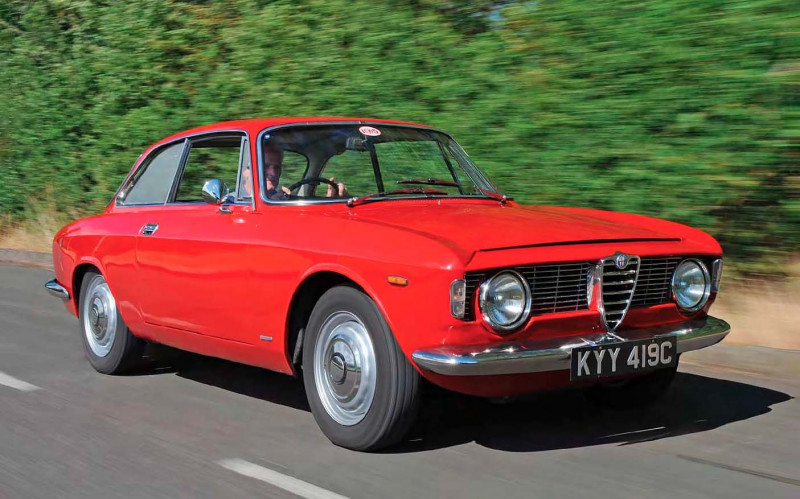
Inside Bill Earlam’s 1965 car, its four-dial dashboard is tastefully minimalistic and wonderfully patinated. The Sprint GT is par for the Tipo 105 course, with a tactile steering wheel, floor-hinged pedals and the five-speed gearbox’s gangly gear lever. In this company, its cabin feels almost understated, the monochrome decor even extending to the 8000rpm rev counter lacking a redline. “It’s a 1965 Giulia Sprint GT which I’ve owned for coming up to 17 years,” says Bill. “It was in 1996 that I got my first Alfa – a narrow-body 1.8-litre 155 – and I’ve had Alfas ever since. In 2005 I got an inheritance and I decided that I would get a nice classic to get keep hold of, and that my wife couldn’t argue with, because I was spending inheritance money!
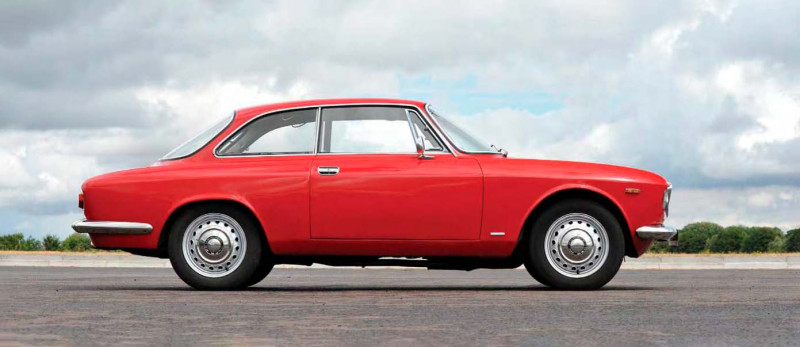
“I pretty much knew that I wanted a 105 Coupe,” says Bill. “I was struggling to find one when I stumbled across this. I hadn’t really thought about a ‘step front’ but this UK-supplied car was from the year I was born, which made it even nicer. It’s had most things done: the engine, gearbox and back axle have all been rebuilt, plus it’s got a modern limited-slip diff. The suspension has had various bushes, ball joints and dampers replaced, and some bodywork resprayed, plus a new headlining.”
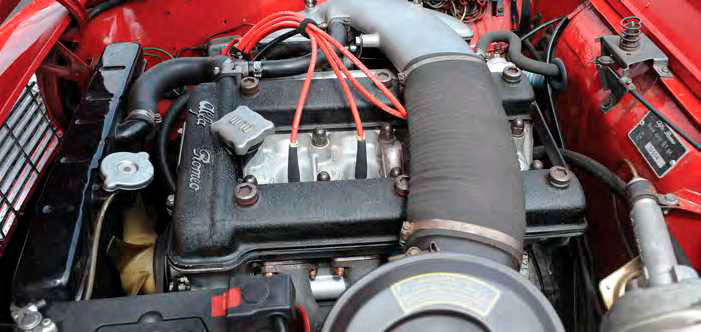
Driving the GT is largely light and easy. This early car still has its cable clutch, Dunlop brakes and 15-inch wheels, so stopping requires more anticipation and thigh power. The fluid, easy-changing five-speed ’box and clutch quickly become second nature. The ride is slightly firm, and cornering is accompanied by body roll, which naturally adds heft to the steering. Whilst we are on the subject, the steering box is nicely geared and consistent from lock to lock, without having a large patch of numb emptiness around the straight ahead. Unlike its larger Tipo 102 sister…
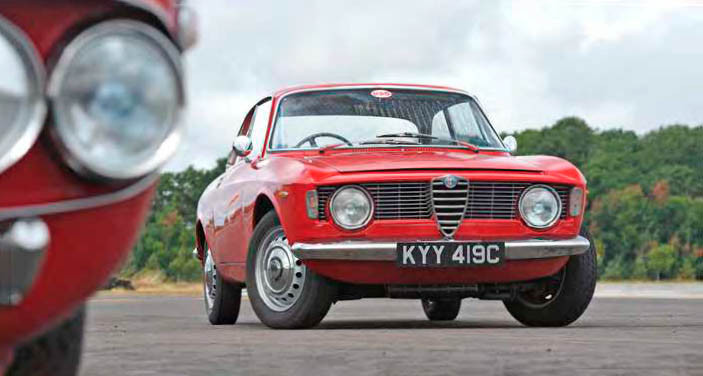
Press on and the GT dances as its 1570cc twin cam delivers torque and power in a wonderfully linear and sweet-voiced manner. Push even further and Bill assures me that the tyres will gently release their grip and slide into a friendly four-wheel drift. Rebuilt to realise slightly more than the factory 106hp, its powertrain retains the original exhaust and silencer. Its subtle note is not as precious as some fettled or bigger Alfa Nord engines, so at A-road speeds the dominant sound is a soft keening from the transmission.
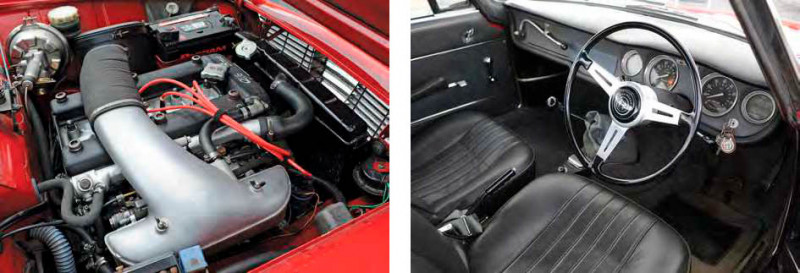
What does Bill like most about his scalino? “Well, number one, you don’t see many of them. Because it’s an early car on skinny tyres, it moves around a bit and you can feel what’s going on a lot more. I’ve had people drive it who are more familiar with 105s on wider tyres and they think it’s more alive, and it doesn’t have heavy steering. I think it’s quite easy to over-tyre them and spoil the feeling.”
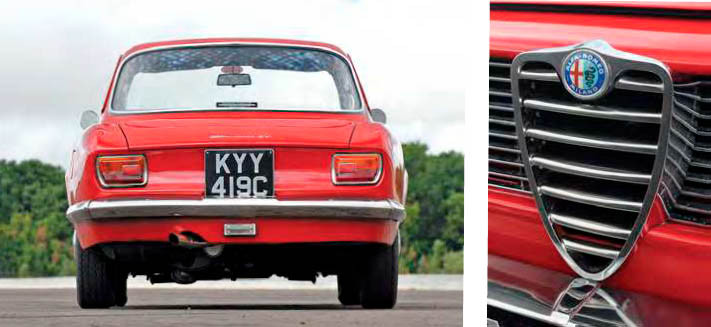
Next up is Giuseppe Rampello’s 1969 Lancia Fulvia 1.3 Rallye S. He says: “I’ve been into Lancias since the age of eight. I remember my cousin working for Fiat-Lancia at the time and being handed a Lancia brochure which listed a Delta S4 Stradale. I remember thinking, ‘Wow, that’s different from a Sierra or Metro!’ and ‘You can actually buy that as a road car!’ I guess it was that brochure that sparked my passion for Lancias.
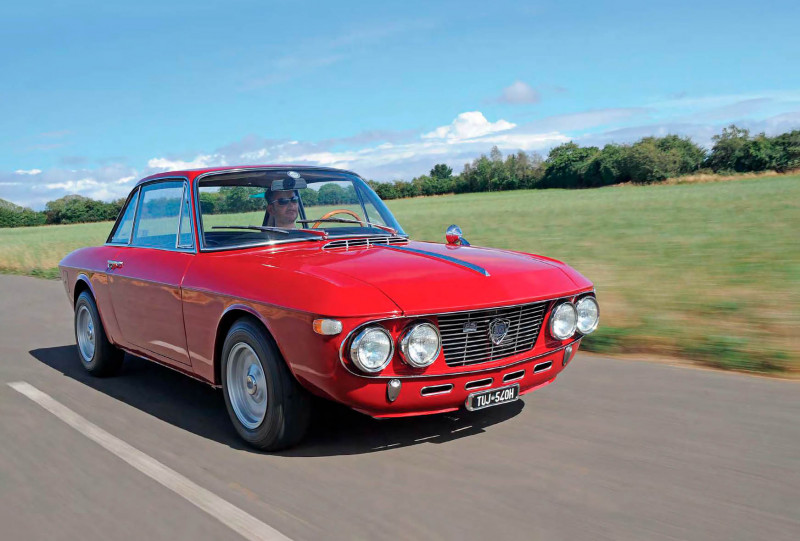
“The reason for buying the Fulvia was the fact that my integrale Evo has appreciated so much (not complaining, mind!). But with its high price tag comes some reluctancy to use it at every opportunity, as it would be extremely difficult to replace. I thought a £10-£15,000 Lancia wouldn’t hurt and may well serve as a good long-term investment.
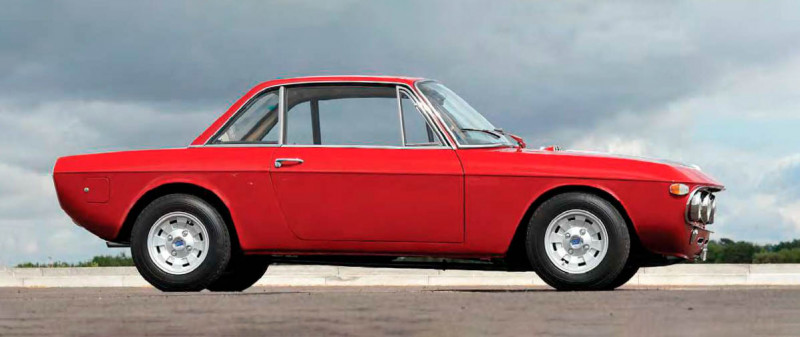
“I purchased it in Turin in September 2018. As a designer, I simply love its aesthetics and really appreciate the engineering of its components – hence why it had to be a Series 1 car, before Fiat downgraded the components and switchgear to make some money from it. I’m told S2s and S3s are a tad nicer to drive but the S1 is the purest form of this design, which does it for me.”
Changing from Alfa to Lancia, the driving feel is dominated by the switch to front-wheel drive. It’s like going from football to tennis. If a rear-driver demands concentration to master cornering using neutrality and throttle balance, the onus on the front-driver is more about front-axle grip and immediate responses – its forte is gleeful chuckability.
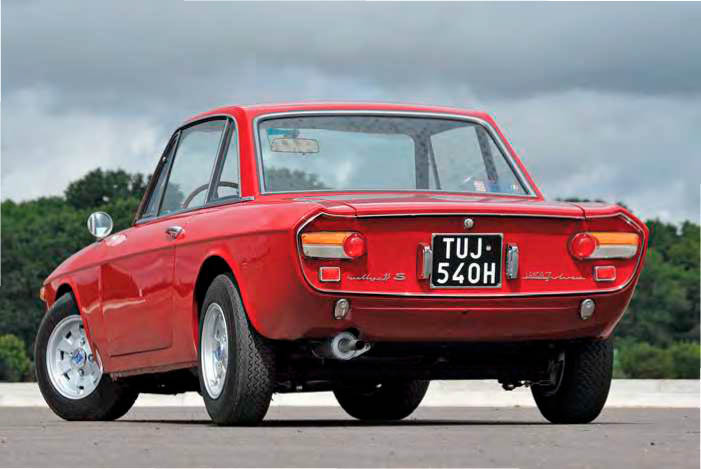
The Fulvia’s cabin backs up its sleek, wood ’n’ alloy appointments with distinctive Lancia touches and quality, while there’s a greater sense of airiness in here than in the Alfa. The four-speeder’s leva lunga may do a passable impression of the Alfa’s lengthy gearstick, but its action isn’t quite so easy-going and fluid.
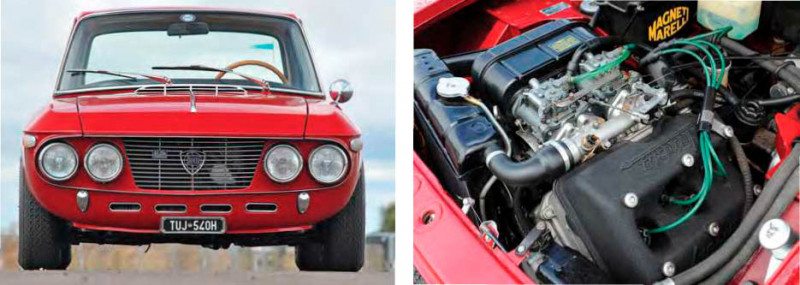
The 1.3 Rallye S took over from the 1967 Rallye 1.3 in 1968, its new 1298cc version of Zaccone Mina’s V4 producing 102hp at 6000rpm. At the time it sat only below the Rallye 1.6HF in the Fulvia Coupe range. Based on Fulvia saloon mechanicals (take a bow Antonio Fessia), its wheelbase was 150mm shorter. The shape was designed by Piero Castagnero and is without doubt one of the sharpest, cleanest and most distinctive GT designs of the 1960s, or – come to think of it – any decade. Whereas most coupe designs do their best to disguise their three-box shape with a slinky off-the-shoulder fastback, the Fulvia doesn’t: it is upright and three-box proud.
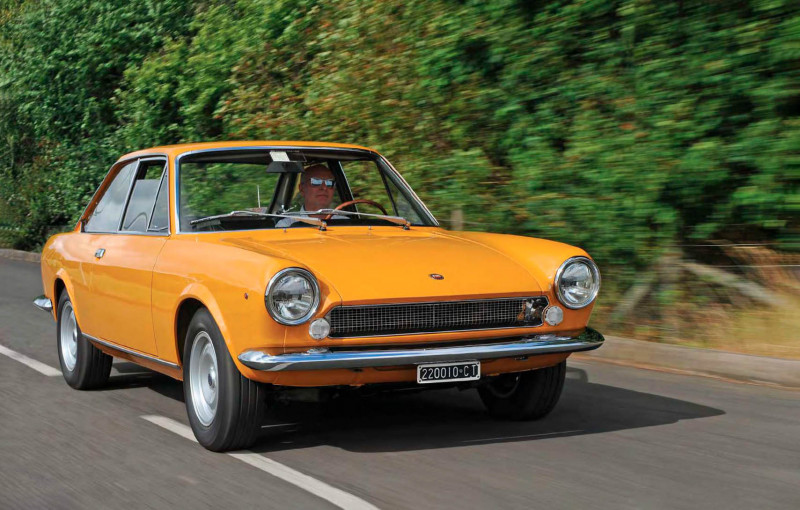
The Rallye S has the smallest engine of our trio. Whilst its linear 102hp output feels comparatively weak, its spirit is willing to tease the 6000rpm redline with a hard-edged hum. Cruising at speed, the lack of a fifth gear is all too obvious. Despite its reliance on leaf springs, its ride quality just edges the Alfa. And even though it’s fitted with 13-inch magnesium alloys and 165-section tyres, the bigger boots don’t corrupt its front end. The steering box remains light and faithful from lock to lock, only slightly loading up in corners. Being picky, the steering could be quicker in order to reward the Fulvia’s grippy chassis better.
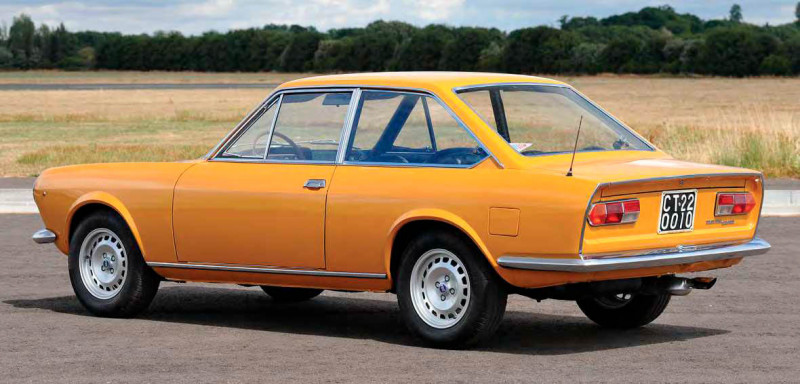
Launched in 1967, and thus the ‘newest’ car here, this Fiat 124 Sport Coupe dates from 1968. The first series (124 AC) happens to be the one least encountered in the UK, which explains why there is something almost mystical about it. The Gandalf of motoring journalism, LJK Setright, was a long-term fan of the model. In the September 1973 issue of Car magazine, he couldn’t help but remark of the third ‘AC’ series: “Readers of long standing may recall our love affair with the original 1400cc version and our despair when the bigger, faster, but less roadworthy MkII came along…” A car he had previously summarised as, “absolute bliss, this was the car that sent everyone wild with delight, it was fantastic, inexplicable.”
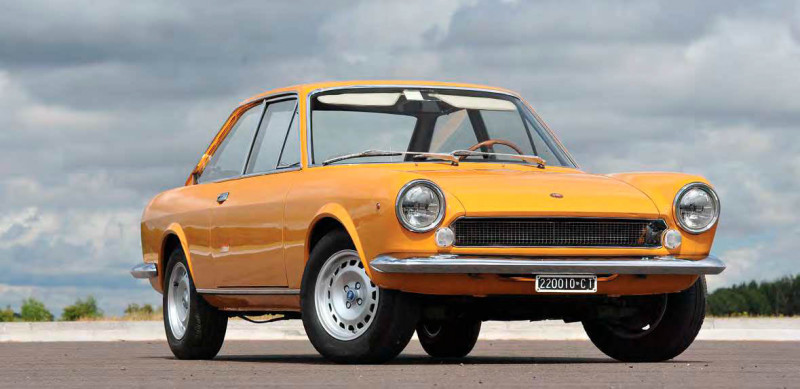
Owner and dealer Nigel Knight admits that he tends to, “Stumble across 124s. In 2016 I went to have a look at a few cars. One was a Fiat Dino 2000 Coupe in Perugia and in his showroom was a 124, which I’d overlooked before then. I’d had Fulvias since I was 18, but this car was mint, there wasn’t any rust on it or anything. I asked to drive it and – my God! It was just unbelievable. It was a CC with a soggy rear end, but it was still a good car. So I bought it – they were peanuts then – and brought it straight back. Since then, I’ve had about ten of them. They are the underdog, I think, and just a fantastic car.
“This 124 was found in a probate sale last year. It had been parked in a garage near Venice since 1973 with 24,000km. It even had its original tyres, which I’ve still got. They were completely flat, and you’d never blow them up again! It’s just not been touched. There are a few dings which have been removed and touched in. I gave it only a very light T-cut because of its history. Otherwise it’s all mechanical stuff – the ball joint rubbers had perished, the brakes were shot, the master cylinders were all rebuilt, it had new dampers, tyres, the oil pressure sender was replaced and all the usual servicing stuff.”
The 124 Sport Coupe’s original coat of Giallo Positano paint emphasises its originality. Oddly, the car sits on Maserati Biturbo 14-inch alloy wheels, which somehow seem to work. Inside, this four-seater is the roomiest and brightest of our trio – proof that Fiat’s father-and-son stylists, Felice and Gian Paolo Boano, didn’t sacrifice practicality for style. Yes, the front end closely resembles Pininfarina’s 124 Sport Spider, but that is long gone aft of the A-pillar, for the cabin terminates in a graceful swooping C-pillar atop a crisp Kamm tail. Here you can certainly see echoes of its 850 Sport Coupe little sister.
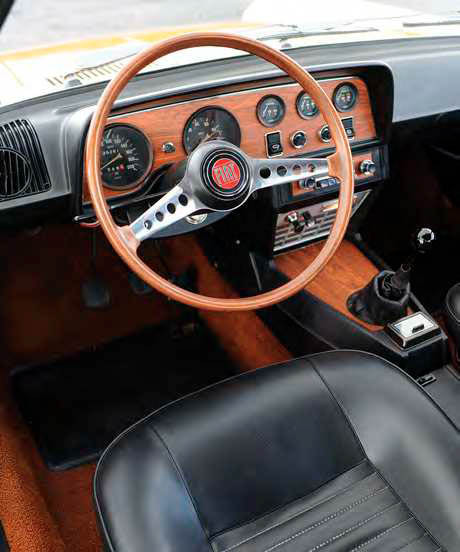
The 124’s double act of light, quick-witted steering and a responsive yet neutral chassis is a revelation
The low-mileage mintiness of this 1968 124 AC really does give you a privileged chance to time travel and experience what this car was like new. The interior trim is hard to fault: everything feels solid and even the courtesy lights all work. Considerable engineering effort was invested in this rear-wheel drive car – twin cam engine, optional five-speed gearbox (box ticked), servo-assisted disc brakes, dashboard light brightness control, column-stalk headlamp dipper and wiper controls, and then the car’s party piece – its chassis.
The steering wheel is connected to a steering box, but it feels lighter, faster and more alive than the other two (its low mileage probably helping matters). The allcoil suspension is optimised by a torque tube that ensures the rear axle obediently stays put — and the end product astounds, even in 2022. The 124 AC quickly and calmly takes you by the hand and in no time you’re into the rhythm and groove of a delightful wriggly road. The double act of light, quick-witted steering and a responsive yet neutral chassis – one that doesn’t seem to understand the concept of ‘roll’ – presents a drive which wouldn’t have felt out of place in the 1990s. It is a revelation.
The only blots on the 124 AC’s copybook are a gearchange that could be better – it has the shortest throw, but its change quality is not as slick as the Alfa’s – and the 1400 Lampredi twin cam. It’s every bit as sweet as the Alfa’s Nord and Lancia’s V4, but there is a frustrating gutlessness to it. Is it because its modest 1438cc capacity is fed by a single, twinchoke Weber carb? Most likely. What power and torque there is, is served up in progressive manner, i.e. there isn’t much until you hit 6500rpm which is where it puts out 90hp and 79lb ft. Oh, for four carburettor chokes and more cubic inches!

Picking a winner is easy: it’s this lucky so-and-so behind the steering wheel. Yes, these are amongst the greatest of 1960s automotive designs, but their chassis also have more than enough talent to make your heart beat with joy during each drive. One drive, though, is more memorable than the others, and that’s not just because this is my first encounter with a Fiat 124 AC. Finally I can see what all the fuss is about. III
Thanks to Bill Earlam, Giuseppe Rampello and Nigel Knight, and to bourneandthomas.weebly.com where the Fiat’s on sale
TECHNICAL SPECIFICATIONS 1968 Fiat 124 Sport Coupe ‘AC’
- ENGINE: 1438cc 4-cyl DOHC
- INDUCTION: Single Weber 34 DHS carb
- POWER: 90hp at 6500rpm
- TRANSMISSION: 5-speed manual (opt), rear-wheel drive
- SUSPENSION: Lower wishbones, coil springs, telescopic dampers, anti-roll bar (front); Live axle, coil springs, trailing arms, radius arms, transverse rod, telescopic dampers, anti-roll bar (rear)
- BRAKES: Discs front and rear
- TYRES: 165-13 (currently 185/70 14)
- DIMENSIONS: 4115mm (L), 1670mm (W), 1339mm (H)
- WEIGHT: 980kg
- MAX SPEED: 102mph
- 0-62MPH: 12.6sec
Superb original paint and Maserati wheels look very striking. Fiat feels great to drive, even in this company
TECHNICAL SPECIFICATIONS 1967 Lancia Fulvia 1.3 Rallye S
- ENGINE: 1298cc V4 DOHC
- INDUCTION: 2 x Solex 35 PHH10 carbs
- POWER: 102hp at 6000rpm
- TRANSMISSION: 4-speed manual, front-wheel drive
- SUSPENSION: Double wishbones, transverse leaf spring, telescopic dampers, anti-roll bar (front); Dead axle, semi-elliptic leaf springs, telescopic dampers, Panhard rod (rear)
- BRAKES: Discs front and rear
- TYRES: 165-13
- DIMENSIONS: 3975mm (L), 1555mm (W), 1300mm (H)
- WEIGHT: 930kg
- MAX SPEED: 108mph
- 0-62MPH: 11.9sec
“ Despite its leaf springs, the Fulvia’s ride quality just edges the Alfa, and its wider tyres don’t corrupt the front end ”
Lancia really feels a class act. Front-drive makes it very chuckable, and V4 engine sports a raspy hum.
TECHNICAL SPECIFICATIONS 1965 Alfa Romeo Giulia Sprint GT Tipo 105
- ENGINE: 1570cc 4-cyl DOHC
- INDUCTION: 2 x Weber 40 DCOE carbs
- POWER: 106hp at 6000rpm
- TRANSMISSION: 5-speed manual, rear-wheel drive
- SUSPENSION: Lower wishbones, coil springs, telescopic dampers, anti-roll bar (front); Live axle, coil springs, trailing arms, radius arms, telescopic dampers (rear)
- BRAKES: Discs front and rear
- TYRES: 155-15
- DIMENSIONS: 4090mm (L), 1570mm (W), 1315mm (H)
- WEIGHT: 950kg
- MAX SPEED: 112mph
- 0-62MPH: 10.6sec
“ The GT dances as its 1570cc twin cam delivers torque and power in a wonderfully linear and sweet-voiced manner ”
Early ‘step front’ Giulia has skinny tyres which give a great feel for the road and lighten the steering


